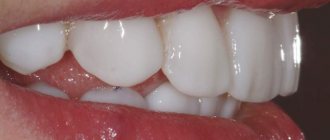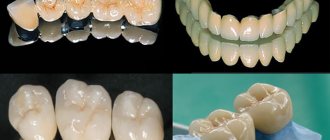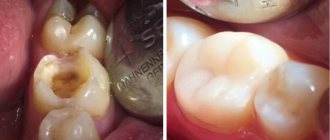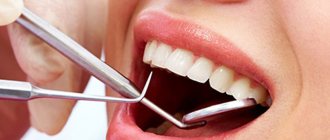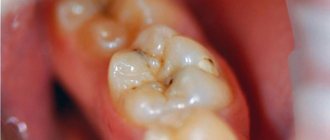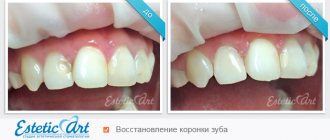Dental restoration or dental restoration is an artistic, direct and aesthetic restoration of the front teeth. Price for dental restoration in Moscow.
Each of us sooner or later faces a situation where teeth lose their aesthetic appeal. This may be due to carious tissue damage or deterioration in the quality of the old filling. In this case, dental units are completely or partially destroyed, their shape changes, and functionality deteriorates. As a result, a person loses one of the most important advantages - the ability to smile beautifully and communicate naturally with the interlocutor.
Today, the only correct solution is dental restoration. This procedure allows you to restore the functional characteristics and shape of damaged teeth using veneers or light-composite fillings.
Today, along with the term “artistic restoration of teeth,” consonant concepts (aesthetic and cosmetic restorations) are often found. However, in practice, they all have the same application and help restore the aesthetics of a damaged tooth.
In our Elident clinic, dental restoration is carried out by highly qualified specialists who master all the intricacies of this process, have the appropriate qualifications and solid experience. We carry out work of any complexity. Even if you need artistic restoration of your front teeth, you can count on an ideal result. Professional knowledge of all stages of dental restoration, an individual approach to each patient, the ability to work with modern materials and a flexible pricing policy - all this makes our services indispensable for patients and increases the chances of a successful outcome of the treatment process.
In this article we will talk about what aesthetic dental restoration is, consider the main methods and stages of its implementation, and provide detailed information on how much dental restoration costs in modern clinics in Moscow.
Free consultation
Our specialists will conduct a free consultation and select the best treatment option for you.
Sign up now! Online registration
+7 (495) 649-41-19
Content
1 What methods of dental restoration exist?
2 Stages of dental restoration
3 Dental restoration before and after photos
4 What influences the price of tooth restoration? 4.1 Complete crown correction
4.2 If half a tooth needs to be restored
4.3 Restoration of a chipped cutting edge of a front tooth
5 What are the disadvantages of artistic dental restoration?
6 Alternative to composite restoration
7 Prices for dental restoration
Alternative ways to restore the beauty of your smile
Artistic restoration using the direct method or using veneers is not the only option. There are also alternative, more radical measures that allow you to restore aesthetics and functionality to injured elements, for example, when there are contraindications to direct extensions and veneers. Let's look at them in a little more detail.
Installation of an artificial crown
Prosthetics with crowns are performed in case of severe destruction of the visible part of the tooth. The root is strengthened with a pin, and an artificial crown made of ceramics, metal-ceramics or, for example, zirconium is fixed on top. Today there is a fairly wide selection of different materials, so patients have the opportunity to choose the best price-quality ratio.
The issue can also be resolved using crowns
If the root is also damaged, the doctor will suggest prosthetics with a crown supported by an implant. In this case, a one-stage implantation can be performed with the installation of a titanium rod in the socket immediately after tooth extraction. If there are contraindications to this technique, implantation can be carried out using a one-stage technology immediately with the installation of an artificial crown. Today this is a convenient and affordable opportunity to restore a lost tooth in the fastest, most correct and reliable way.
Dental restoration with inlays
In essence, we are talking about a large filling that is created in the laboratory using impressions of the patient’s jaws. The finished product accurately follows the shape of the cavity and can ensure the tightest possible fit of the material to the dental tissues.
Important! The restoration tab should not be confused with the stump insert. The first is a large filling, the second serves as a support for an artificial crown if the tooth is destroyed by more than 2/3.
The photo shows dental inlays
Such inlays are indicated in cases where the crown is destroyed by caries by more than a third. They are used to restore only lateral molars. To cover defects in the front teeth, veneers and lumineers are used.
Correcting curvature with braces
If the problem is that the teeth are initially in the wrong position, you will need to undergo orthodontic treatment. Most often, in such cases, permanent braces are prescribed. And if veneers help hide minor curvatures or gaps between teeth, more complex anomalies cannot be corrected with thin overlays. But today, manufacturers of modern brace systems offer a fairly wide variety of different models, including those made from materials that meet the highest standards of aesthetics.
Braces - good for correcting malocclusion
Ceramic and sapphire braces are practically invisible on the teeth, while metal lingual braces are attached on the inside side by side. You just need to take into account that treatment with such systems will not be very cheap. The most expensive will be lingual models - they are completely invisible to others, successfully cope with complex defects, and do not prolong the treatment period. Ceramic and sapphire are distinguished by easy sliding of the arc in perfectly smooth grooves, which is why they do not have sufficient impact on problem areas. Treatment with them lasts longer than with metal ones. The latter, by the way, are considered the most budgetary, but at the same time the most effective option.
What methods of dental restoration exist?
Currently, artistic restoration of teeth is carried out using the following two methods:
- Direct dental restoration : carried out using light-curing fillings. Dental restoration using composite materials, which is carried out by a specialist in therapeutic dentistry;
- Dental restoration with veneers : This procedure involves a prosthetic specialist who prepares the tooth and makes an impression. Next, the process of creating the veneer itself is carried out, which involves the use of ceramic or zirconium material. The resulting plate is glued to the outer surface of the tooth. As a rule, veneers are used when restoration of the front teeth takes place. Despite their inflated cost, they have a number of advantages.
Features of the restoration of the frontal group
To restore the smile area, the material is selected taking into account the natural shade of the enamel. In addition, such characteristics as shade and translucency in different parts of the tooth must be taken into account. Thus, the restoration procedure must take into account the following visual features:
- The dentin in the area of the cutting edge is thinner, and the enamel layer is dense. This explains the increased translucency in this part,
- closer to the gum, the enamel becomes thicker, and the dentin becomes thinner,
- in the cervical area, the enamel is thinner, and the volume of dentin is larger - here the tooth appears darker and less transparent.
The material is selected taking into account the natural shade of the enamel.
This heterogeneity of the surface of the incisors significantly complicates the task of the specialist. It is important to achieve a perfect resemblance to natural enamel, otherwise any minor flaws will immediately be evident. And this is one of the reasons why restoration of incisors usually costs more than restoration of premolars and molars.
Stages of dental restoration
Next, we will talk in detail about how aesthetic restoration of anterior teeth is performed. An example will be a situation where a patient needs to restore a front tooth with old fillings that have lost their aesthetic appeal.
So, the restoration of the front teeth includes the following sequential stages:
- Preparing teeth. At this stage, dental units are cleaned of plaque, the shade of the destroyed tooth is determined and, based on it, the color of the photopolymer filling is selected.
- Administration of anesthetics (if necessary).
- Removal of tissues affected by caries . When there is a need to replace an old filling material that has lost its aesthetic qualities, it is drilled out.
- Elimination of excessive salivation . If previously cotton swabs were used for this purpose, now they use an innovative product - cofferdam. This is a material made of latex, which has special holes for teeth. Thanks to such a latex scarf, it is possible to qualitatively isolate the oral cavity from wet breath and saliva, which ensures a more reliable process for installing photopolymer fillings. If insulated incorrectly, dental restorations made with light-curing materials can quickly lose their properties. This will create an unwanted dark line between the tooth and the filling, or cause the composite material to fall out.
- Installation of the pin . It is used if there is massive destruction of the crown and there is no nerve in the tooth itself. In this case, tooth restoration is carried out on a pin, which plays the role of a strengthening element and prevents the restoration from falling out.
- Dental restoration with composite material . In order to give the tooth a natural appearance, a special technique for applying photopolymer mass is used. For this purpose, the light-curing material is applied in layers. It is thanks to the presence of layers with varying degrees of transparency and different color tones that it is possible to obtain a natural tooth shade.
- The final stage . The final processing of the dental unit is carried out, which includes grinding and polishing the filling material.
Aesthetic restoration – the essence of the procedure and main indications
When answering the question of what artistic restoration is and when it is done, you should immediately note that this is a whole complex of different techniques, each of which is aimed at restoring the shape of a damaged or destroyed tooth, restoring the aesthetics and functionality of the smile as a whole. Among the indications for restoration, dental experts identify the following phenomena:
- pronounced yellowing or darkening of the enamel, pigmentation,
- thinning of the enamel layer,
- presence of chips and cracks, gaps between teeth, slightly crooked teeth,
- partial destruction of the crown,
- extensive caries,
- loss of old fillings, darkening of the material,
- Diastema is a large gap between the upper front teeth.
Artistic restoration will help restore damaged teeth.
Separate techniques are also used in cases where there may be no obvious dental indications for restoration. For example, when you are not satisfied with the shape or size of your teeth, when you want to make your smile look snow-white in Hollywood. In these cases, veneers and lumineers come to the rescue, but let’s talk about popular restoration methods in order.
What influences the price of tooth restoration?
When a patient requires dental restoration, price is a key concept that influences his decision. Moreover, the cost often depends on the volume of tissue that needs to be restored, as well as on the material that is used in the process of restoration work. That is, if you are interested in how much it costs to restore a tooth, you should pay attention to whether it is partially restored or whether the crown is completely corrected.
Complete crown correction
Complete restoration of the tooth crown is carried out if the volume of destroyed tissue reaches more than half of the volume of the entire dental unit. In this case, tooth restoration takes place, the cost of which is influenced by the following factors:
- The cost of the anesthesia procedure: can reach 250-300 ₽;
- Elimination of salivation using coffee drum - can have a price of 300 ₽ and more;
- Using a sterile kit – from 150 ₽;
- If a tooth needs to be restored with a composite material, the price can be about 3-4 thousand rubles;
- Installation of a fiberglass pin – from 1,500 ₽. When using a high-quality reinforcing plate, it is possible to avoid sudden crown fractures associated with chewing hard foods. If restoration of anterior teeth is carried out, the price of the pin plays a decisive role. Although the metal material is much cheaper, fiberglass pins are more reliable and aesthetically pleasing. They do not give an undesirable bluish tint, have a transparency identical to natural teeth, are securely fixed in the dental canal and have good adhesion to composite fillings.
On average, in Moscow dental centers, a complete dental restoration costs 6-8 thousand rubles.
At the Elident clinic, a complete restoration of the crown part of a tooth with a light-curing material costs 6,500 rubles. We provide anesthesia at a price of 500 ₽, and applying an insulating pad costs 450 ₽. As for the payment for the fiberglass pin, we offer to install it for 1,600 ₽.
If you need to restore half a tooth
If the tooth was not completely destroyed and there is no need to use a pin made of fiberglass material, dental restoration will have a more affordable cost. Even taking into account all the associated costs, restoring half a tooth will cost you about 3,000 - 4,000 rubles.
Restoration of a chipped incisal edge of a front tooth
If you are restoring a small part of a tooth with a root present, you will only have to pay for the procedure for administering anesthetic agents and a composite filling. That is, restoration of chipped front teeth with filling material in mid-price dentistry will cost about 2 thousand rubles.
What problems may appear after recovery?
Over time, even modern light-curing materials darken, lose their shine and begin to stand out against the background of living enamel. For lateral molars, this may not be as critical as for the teeth of the frontal group, where such defects can clearly ruin a beautiful smile. If a larger-scale restoration was carried out, for example, a large part of the pulpless crown was restored, then the risk inevitably arises that the artificial material will break off. It must be taken into account that teeth with removed nerves are especially fragile. If the root is fractured at the same time, complete removal will be required.
Artificial material may break off
What are the disadvantages of artistic dental restoration?
Despite all the advantages that aesthetic dental restoration has, it can have several negative aspects. These include:
- Gradual loss of shine and natural shade. When composite dental restoration is carried out in any clinic in Moscow or any other city in the Russian Federation, no one will give you a guarantee of a prolonged result. The fact is that photopolymers over time can lose their original characteristics and darken, which leads to the loss of the external attractiveness of teeth and the need to replace the restoration material.
- Possibility of breakdown . If the volume of destroyed tissue exceeds more than 1/2 of the total volume of the tooth, and the dental nerve was previously removed, there is a high risk of crown breakage. Such dental units are very fragile, and breakage can occur when eating any hard food. However, restoring a broken tooth is not a solution to the problem. Experts recommend giving preference to installing an artificial crown.
Restoration of the incisal edge
Enamel is the hardest tissue in our body. But over time, it becomes thinner, including due to improper brushing techniques or the use of abrasive pastes. This is fraught with the appearance of microcracks and chips on it. Especially at risk are those who have bad habits: chewing seeds, nuts, or the tip of a ballpoint pen. Restoration of the cutting edge of the tooth helps to correct the shape of the tooth and its cutting edge, and hide enamel defects.
This is not an easy procedure that requires painstakingness and creativity, because the anatomical shape of everyone’s teeth is different. In addition, the tooth has a relief, individual shade and transparency. The specialist’s task is to make sure that the restored tooth does not differ from the rest.
Front Tooth Reconstruction. Source: Futurism YouTube channel
Few people know that the color of the enamel changes from the neck to the cutting edge. It seems that the changes are insignificant, but if this feature is not taken into account, the restored tooth will look like a plastic crown. The same can be said about transparency.
Our clinics
Clinic "Elident" on Varshavskaya
Varshavskoe highway, 75, bldg. 1, Moscow 117556
- Varshavskaya (500 m, closed until 2021)
- Nakhimovsky Prospekt (1,300 m)
Mon-Sat : 09:00-21:00; Sun : 09:00-19:00.
Online registration
+7 (495) 649-41-19
Elident Clinic in Annino
Varshavskoe highway, 154, building 1, Moscow 117405
- Annino (500 m)
- Academician Yangelya (700 m)
Mon-Sat : 09:00-21:00; Sun : 09:00-19:00.
Online registration
+7 (495) 649-41-19
Method of layer-by-layer application of composite
In recent years, when restoring class IV defects, the technique of layer-by-layer application of a composite has been used, for which there are a large number of terms: “anatomical superstructure”, “three-layer concept” or “natural layer concept” [2]. The essence of this technique is to imitate natural enamel and dentin [3]. However, not all composite materials available on the dental market can perfectly imitate tooth tissue.
The main problem with traditional composite materials is the dependence of the light transmission of transparent composite materials on the layer thickness. Therefore, the doctor has to very carefully calculate the thickness of the applied dentin and enamel shades of the material to obtain a satisfactory aesthetic result.
However, clinically it is very difficult to determine and limit the thickness of the layer with an accuracy of tenths of a millimeter, therefore, as a rule, a thicker layer of mass is applied, which is then ground off. The slightest fluctuations in layer thickness can significantly affect the final appearance of the restoration [4].
The main problem of traditional composite materials is the dependence of the light transmittance of transparent composite masses on the layer thickness
Alternative to composite restoration
- Veneers. When dental restoration with photopolymers takes place, the price is not in doubt among patients and they immediately agree to the procedure. However, there are cases when a more preferable option for restoring teeth is installing veneers. The need to apply such reinforcing plates arises if tooth decay occurs only in the anterior part, and on the lingual side the tooth is only slightly damaged.
Moreover, it is better to install ceramic veneers, which do not lose their shine over time and do not fade. Despite all the advantages that such alternative dental restoration has, its price in Moscow remains high.
Even in budget dental clinics, installing veneers will cost you no less than 15,000 rubles. In high-level metropolitan dentistry, prices for veneers made of zirconium can reach 30-40 thousand rubles. However, this price includes all additional costs associated with anesthesia, x-rays, impressions and even a temporary plastic crown.
In our clinic, a ceramic veneer costs 25 thousand rubles, and the price of a zirconium veneer is 15 thousand rubles.
- Artificial crowns . Also, if there is significant destruction of the dental unit (more than 50%), the priority option is to install an artificial prosthesis. This is due to the fact that complete tooth restoration (from the root) has a cost similar to a metal-ceramic crown. However, in terms of strength and aesthetic parameters, the latter is considered a more preferable choice.
- Inlays . If necessary, a special restorative inlay can be used to restore chewing teeth. If such an inlay is made of ceramic material, it is more durable, stronger and more aesthetically pleasing than composite fillings.
How is restoration carried out?
First of all, the teeth are prepared, caries is eliminated, endodontic treatment is carried out, and if necessary, professional cleaning is carried out. Restoration with filling material is carried out immediately, in one visit. If you plan to install veneers or crowns, the teeth are ground down. After the surface is prepared, impressions are taken and temporary dentures are installed for the patient. When the permanent structures are ready, they are installed in their places.
Care after restoration requires maintaining a high level of hygiene, as well as regular preventive examinations.
Author:
Mayorov Andrey Mikhailovich
Specialization:
orthopedic dentistry, dental prosthetics, implant installation
